Quick Links
Ancient Roman ruins dot the Mediterranean and beyond. Turkey, Italy, and southern France are famous for having some of the best Roman ruins still around today. But there are plenty of other Roman ruins in less-traveled countries around the region. Tunisia, for example, is home to a Colosseum, every bit as fascinating as the Colosseum of Rome but lacks the crowds, and visitors are much freer to explore it and its tunnels.
But unfortunately, some of the best Roman ruins are located in countries difficult to visit (like Syria and Libya). Leptis Magna is one of the most impressive Roman cities today, with extensive ruins, but it lays abandoned in Libya today. Other places like Nimes in southern France have many excellent Roman ruins and are much more accessible.
History Of Leptis Magna - The Roman Jewel Of Libya
Leptis Magna was enlarged and embellished by Emperor Septimius Severus (who was born there). In its heyday, Leptis Magna was one of the most beautiful cities of the Roman Empire. It was home to imposing public monuments, a harbor, a bustling marketplace, and much more.
Before the Roman Empire, Leptis Magna was one of the great cities of the Carthaginian Empire. After it passed under Roman control, it was one of the leading cities of Roman Libya.
Leptis Magna was originally founded by the Phoenicians in the 7th century BC. Emperor Septimius Severus (rules 193 to 211 AD) greatly expanded the city. It was the task of the 3rd Augustan Legion to defend the city against Berber attacks.
Western Roman rule came to an end in 439 AD when it was taken over by the Vandals but was reincorporated into the remaining Eastern Roman Empire (aka Byzantine Empire) in 533. Although at this time, it was plagued by Berber raids, and it never recovered to what it had been. It was abandoned sometime after it fell to the Muslims in around 647.
Septimius Severus: The Roman Emperor From Leptis Magna
Emperor Septimius Severus was born in 145 AD in Leptis Magna and worked his way up the Roman ranks. He waged military campaigns across Europe and as far as what is today Iraq. He eventually died in York (then Eboracum), England.
Septimius Severus put an end to the tumultuous period of the Year of the Five Emperors by seizing power after the death of emperor Petinax and then defeating his rivals. He launched many campaigns and expanded the empire and going as far as sacking the Parthian Empire's capital of Ctesiphon in 197. In 208, he traveled to Britain and campaigned in Caledonia in what is today Scotland. He reoccupied the Antonine Wall deep in Scotland (the remains of which can still be seen today).
His campaigns in Scotland were cut short when he contracted an infectious disease in 210, and he died the following year. This death was soon followed by the destructive Crisis of the Third Century that nearly spelled the end of the Roman Empire (but it managed to come back from the brink).
What To Expect In Leptis Magna Today
Today Leptis Magna is located in Khoms, Libya, around 80 miles east of the capital of Tripoli. It is one of the best-preserved Roman sites in all of the Mediterranean. Unfortunately, the Civil War and struggles of Libya over the last decade or so have seen Leptis Magna neglected by the government and shunned by tourists.
- Location: Khoms, Libya
- Designed: UNESCO World Heritage Site Since 1982
These days only a few tourists go to see this magnificent example of Roman engineering and architecture. Those who do visit Leptis Magna are nearly all Libyans.
It is perched on a hillside overlooking the Mediterranean; some of the impressive ruins include:
- A Large Basilica
- A Racecourse
- A Theater With Seating For 15,000 Spectators
- Arched Terraces Overlooking The Mediterranean
While the site has fortunately largely escaped the ravishes of the wars in Libya, it is wanting for maintenance, and archeological digs have long since ceased. Still, it has been called the Jewel of the Roman Empire.
One of the best places to relive the lost days of the Roman Empire is in a Roman arena in France that houses the annual Great Roman Games and epic re-enactments.

